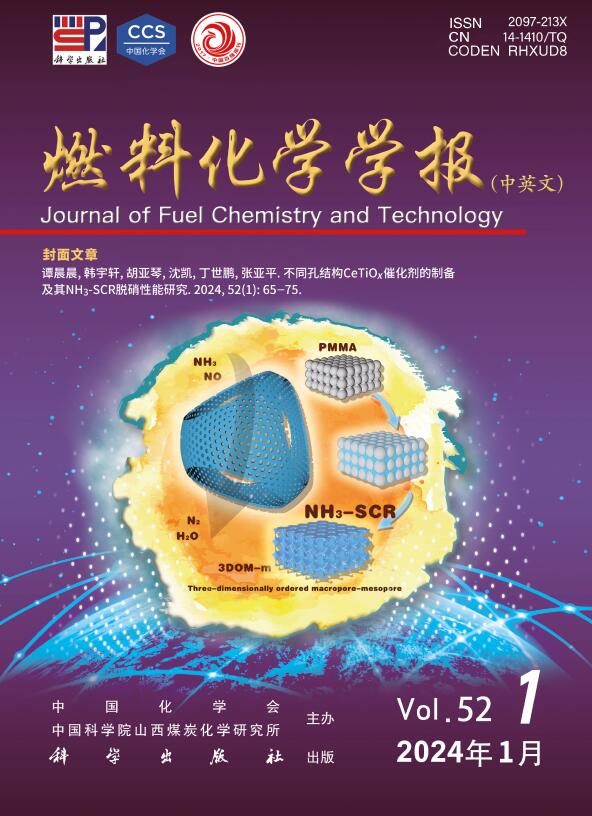Ru/MxOy催化甲醇蒸汽重整反应的载体效应
Q3 Energy
引用次数: 0
摘要
以CeO2、ZrO2、γ-Al2O3、AlO(OH)为载体,RuCl3为钌源,采用沉积沉淀法制备Ru/MxOy催化剂。通过XRD、BET、H2-TPR、XPS等表征方法,结合高通量甲醇蒸汽重整制氢反应评价,考察了不同载体对Ru/MxOy催化剂催化性能的影响。实验结果表明,若氧与载流子相互作用的差异,以及氧空位的存在与否,都表现出明显的载流子效应。以CeO2为载体制备的Ru/CeO2催化剂具有RuOx分散性好、RuOx与载体相互作用强、氧空位率高、催化活性好的特点。在反应温度为420℃,水醇摩尔比为1.2,甲醇水质量空速为6 h−1的条件下,甲醇转化率为88.64%,在高通量下催化活性良好。本文章由计算机程序翻译,如有差异,请以英文原文为准。
Carrier effect of Ru/MxOy catalyzed methanol steam reforming reaction
Using CeO2, ZrO2, γ-Al2O3, AlO(OH) as the carrier and RuCl3 as the ruthenium source, the Ru/MxOy catalyst was prepared by deposition-precipitation method. Through XRD, BET, H2-TPR, XPS and other characterization methods, combined with high flux methanol steam reforming hydrogen production reaction evaluation, the influence of different carriers on the catalytic performance of Ru/MxOy catalyst was investigated. The experimental results showed that the difference of the interaction between RuOx and the carrier, as well as the presence or absence of oxygen vacancy, showed a significant carrier effect. The Ru/CeO2 catalyst prepared with CeO2 as the carrier has good dispersibility of RuOx, strong interaction between RuOx and the carrier, oxygen vacancy, and good catalytic activity. At the reaction temperature of 420 ℃, the molar ratio of water to alcohol is 1.2, and the space velocity of methanol water mass is 6 h−1, the methanol conversion rate is 88.64%, and the catalytic activity is good at high flux.
求助全文
通过发布文献求助,成功后即可免费获取论文全文。
去求助
来源期刊

燃料化学学报
Chemical Engineering-Chemical Engineering (all)
CiteScore
2.80
自引率
0.00%
发文量
5825
期刊介绍:
Journal of Fuel Chemistry and Technology (Ranliao Huaxue Xuebao) is a Chinese Academy of Sciences(CAS) journal started in 1956, sponsored by the Chinese Chemical Society and the Institute of Coal Chemistry, Chinese Academy of Sciences(CAS). The journal is published bimonthly by Science Press in China and widely distributed in about 20 countries. Journal of Fuel Chemistry and Technology publishes reports of both basic and applied research in the chemistry and chemical engineering of many energy sources, including that involved in the nature, processing and utilization of coal, petroleum, oil shale, natural gas, biomass and synfuels, as well as related subjects of increasing interest such as C1 chemistry, pollutions control and new catalytic materials. Types of publications include original research articles, short communications, research notes and reviews. Both domestic and international contributors are welcome. Manuscripts written in Chinese or English will be accepted. Additional English titles, abstracts and key words should be included in Chinese manuscripts. All manuscripts are subject to critical review by the editorial committee, which is composed of about 10 foreign and 50 Chinese experts in fuel science. Journal of Fuel Chemistry and Technology has been a source of primary research work in fuel chemistry as a Chinese core scientific periodical.
 求助内容:
求助内容: 应助结果提醒方式:
应助结果提醒方式:


